Lexus NX 350 F Sport 2.4 (A) vs Audi Q5 2.0 (A) vs BMW X3 xDrive30i (A)
21 Oct 2022|32,610 views
Lexus NX 350 F Sport
Swankiest design
Most luxurious interior
Nimblest handling
Most progressive response
Audi Q5
Sportiest performance
Controls feel the most tactile
Neatest handling
Most functional cockpit
BMW X3 xDrive30i
Roomiest and most practical
Most user-friendly cockpit
Best ride quality
Smoothest power delivery
Mid-size luxury SUVs are the aspiration of many car buyers today. They have the body style that many drivers seek, along with the luxury and power to make them enjoyable.
It's no surprise then, that the German makes are well-established in this segment, with one of the most popular models being the BMW X3. Recently facelifted, the X3 comes with a redesigned front and rear, along with new head lights and taillights. Of greater significance is that all X3 engine variants now have 48-volt mild hybrid systems for better efficiency and refinement.
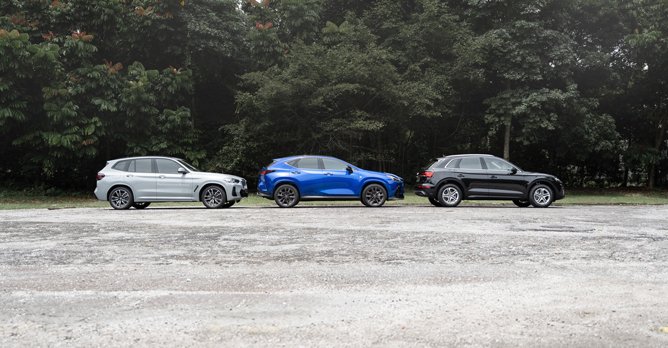
Our third contender in this story is the Audi Q5. Also recently updated, the Q5 boasts sharper exterior styling and upgraded infotainment that makes the SUV even more user-friendly than before.
Will the German brands have the edge in this story? Or will their Japanese rival be able to spring a surprise?
Style book
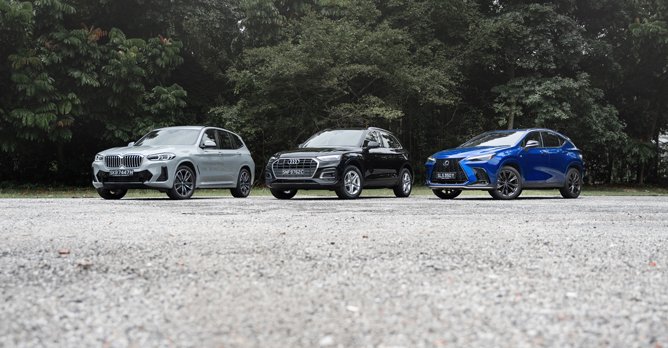
BMW's 'light touch' approach to the exterior styling is conservative, but it also reflects the fact that the car has a strong design to begin with, so it doesn't need major changes.
Audi employs the same philosophy for its models, which is why it would seem as if the Q5 is totally unchanged. In fact, the Q5's understated styling is the least striking of the group. It needs the S Line option to give it more 'pop'.
The NX is the most attractive of the three SUVs. Its sizeable grille, arrow-like daytime running lamps and chiselled front end make it look the most dynamic. The gunmetal wheels and L-shaped taillights further complement its sporty design.
Behind the wheel
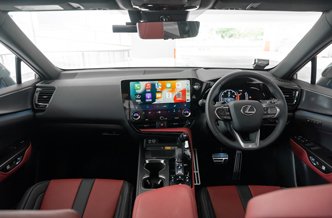 | 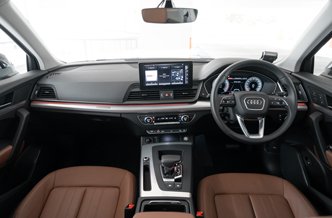 |
Lexus' reputation for build quality and luxury is well-deserved, for the NX's interior not only looks expensive - it feels expensive, too. The colours, soft-touch materials and seat surfaces all ooze quality.
A head-up display is standard, along with the useful touch-operated panels on the steering wheel for the audio system and cruise control. There are electronic door latches, too.
The X3, on the other hand, is the most intuitive and practical of the three contenders. Constant refinements to the iDrive system have further enhanced its user-friendliness, so a first-time owner can get the hang of it in no time at all.
 | 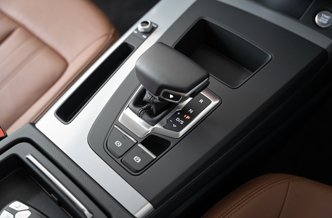 |
With regard to practicality, the X3's generous door bins easily accommodate large water bottles, with enough room leftover for other loose items. And given the car's size, the cockpit is also the airiest.
At first glance, the Q5's cockpit seems the least interesting, for its neat and minimalist design doesn't have the NX's pizzazz. But spend a bit more time in here and you'll find it's a pleasing place to be in.
The fit and finish is tight, and with fewer buttons and switches, there are also fewer distractions. The remaining controls have the best tactility as well, so with every press, you hear a distinct click. It may seem as if the Q5 offers less, but really, if you look closer, you'll discover that Audi's straightforward approach definitely has its merits.
Practical aspects
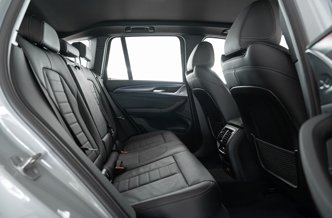 | 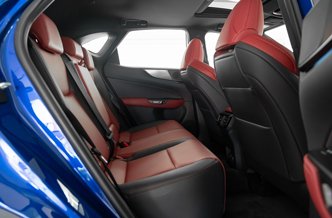 |
There's plenty of foot space for occupants to park their feet, and roomy door bins for any loose items. Naturally, the X3 also has the largest boot capacity, offering 550 litres with the rear seats up. That's 30 litres more than what the NX and Q5 offer.
While the Q5 does not have as much legroom as the X3, it's the middle occupant that will feel the squeeze, since the bench is narrower than the BMW's. It's also the least convenient, since it's the only one that doesn't offer charging ports.
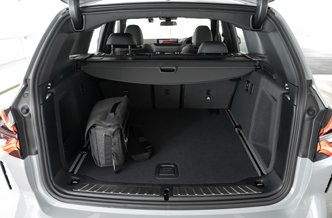 | 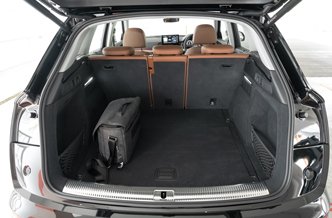 |
Now, although the NX has the most compact dimensions, designers did a good job packaging the rear bench, for the space feels similar to the Q5.
More importantly, this backseat is the plushest. Combined with those deep-pile carpets, passengers sitting here who just had a big meal are likely to fall asleep.
As for the boot volume, the efficient packaging enables the NX to also offer 520 litres. It would've been more flexible, though, if 40:20:40 split-folding rear seats are employed next time.
Power and performance
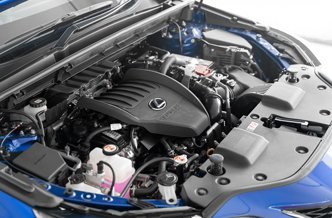 |  |
But the NX makes up for this by offering the most linear performance. If you're used to naturally aspirated engines, the one here feels like one, and responds well to being revved.
With its well-tuned chassis and Adaptive Variable Suspension, the NX is the nimblest of the three SUVs. It's rewarding even when piloted around built-up areas.
Powered by a turbocharged 2.0-litre in-line four, the X3 xDrive30i delivers 241bhp and 350Nm to all four wheels via an eight-speed automatic gearbox. Zero to 100km/h is accomplished in 6.6 seconds.
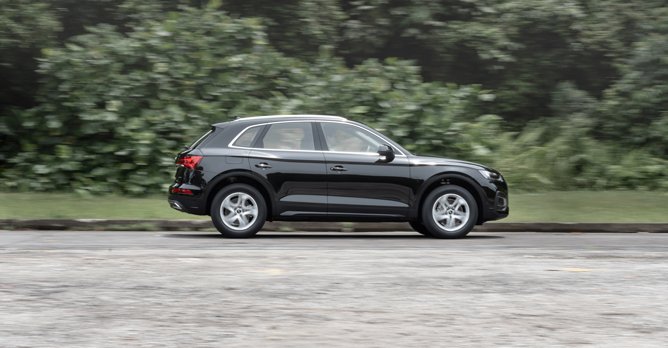
The sportiest performer here is the Q5. With 245bhp and 370Nm from its turbocharged 2.0-litre powerplant, it finishes the century dash in 6.3 seconds.
Audi's seven-speed dual-clutch gearbox contributes to this zippiness. But performance aside, it's the least engaging to drive. As for handling, the Q5 is neat and predictable, while its ride quality is between the X3 and NX.
Pondering points
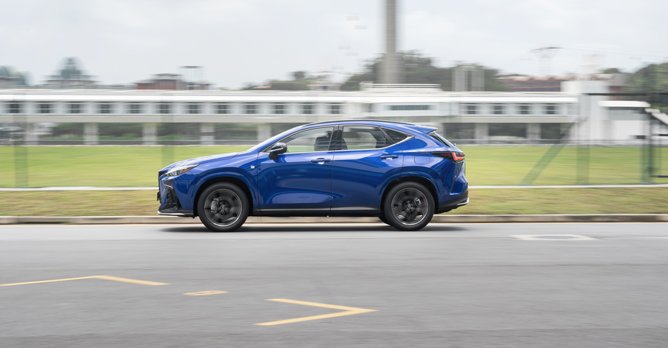
The Q5 is the least compelling option for me, but it isn't because it's a bad car. It is solidly built, has a punchy drivetrain, while the functional interior makes a lot of sense.
What I want from the Q5 is for it to be more involving, especially from a design and handling standpoint. Nevertheless, it is a great choice for a driver who wants an SUV that's neat and predictable. As a bonus, it's the least expensive option, too.
The best all-rounder of the trio is the X3. Its size and roominess give it a commanding lead in terms of space, flexibility and practicality.
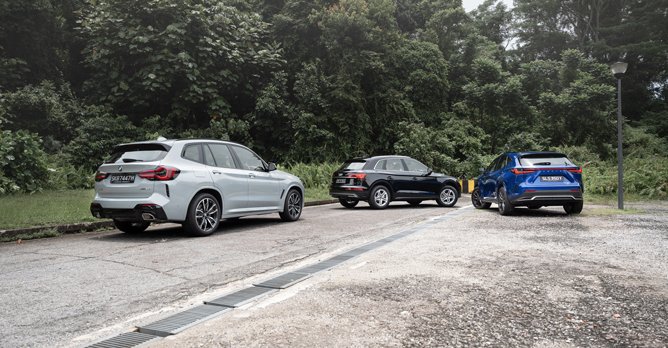
However, although the X3 is the most useful SUV here and thus arguably the one to have, it's too much car for just myself and my wife. If we had kids, there's no question it would be the top choice.
This is why I find the NX 350 to be even more compelling than the X3. Its striking design gives it the most road presence, while its well-appointed interior feels the most expensive.
Would it have been better if it were quicker? Of course. But the NX's progressive power delivery and agile handling make it an engaging drive, which is something I would look forward to every time I get behind the wheel.
Looking to compare more cars? Check out these other Group Tests
We pit the Audi A3 Sedan 1.0 against the BMW 216i Gran Coupe
Mazda CX-5 meets the Volkswagen Tiguan
Nissan Qashqai faces off against the Skoda Karoq
Honda HR-V lines up alongside the Peugeot 3008
Mercedes-Benz CLA180 goes head-to-head with the BMW 216i Gran Coupe
Opel Mokka takes on the Renault Captur
Polestar 2 Long Range Single Motor goes up against the Tesla Model 3
Audi Q5 lines up alongside the Jaguar F-Pace
Lexus NX 350 F Sport
Swankiest design
Most luxurious interior
Nimblest handling
Most progressive response
Audi Q5
Sportiest performance
Controls feel the most tactile
Neatest handling
Most functional cockpit
BMW X3 xDrive30i
Roomiest and most practical
Most user-friendly cockpit
Best ride quality
Smoothest power delivery
Mid-size luxury SUVs are the aspiration of many car buyers today. They have the body style that many drivers seek, along with the luxury and power to make them enjoyable.
It's no surprise then, that the German makes are well-established in this segment, with one of the most popular models being the BMW X3. Recently facelifted, the X3 comes with a redesigned front and rear, along with new head lights and taillights. Of greater significance is that all X3 engine variants now have 48-volt mild hybrid systems for better efficiency and refinement.

Our third contender in this story is the Audi Q5. Also recently updated, the Q5 boasts sharper exterior styling and upgraded infotainment that makes the SUV even more user-friendly than before.
Will the German brands have the edge in this story? Or will their Japanese rival be able to spring a surprise?
Style book

BMW's 'light touch' approach to the exterior styling is conservative, but it also reflects the fact that the car has a strong design to begin with, so it doesn't need major changes.
Audi employs the same philosophy for its models, which is why it would seem as if the Q5 is totally unchanged. In fact, the Q5's understated styling is the least striking of the group. It needs the S Line option to give it more 'pop'.
The NX is the most attractive of the three SUVs. Its sizeable grille, arrow-like daytime running lamps and chiselled front end make it look the most dynamic. The gunmetal wheels and L-shaped taillights further complement its sporty design.
Behind the wheel
The NX's cockpit (left) looks attractive and feels classy, while the Q5's space, though well-constructed, looks sombre in this company
Echoing the NX's exterior is its equally snazzy cockpit, which is dominated by a 14-inch high-definition touchscreen, which has punchy graphics and quick-loading menus.Lexus' reputation for build quality and luxury is well-deserved, for the NX's interior not only looks expensive - it feels expensive, too. The colours, soft-touch materials and seat surfaces all ooze quality.
A head-up display is standard, along with the useful touch-operated panels on the steering wheel for the audio system and cruise control. There are electronic door latches, too.
The X3, on the other hand, is the most intuitive and practical of the three contenders. Constant refinements to the iDrive system have further enhanced its user-friendliness, so a first-time owner can get the hang of it in no time at all.
The X3's gearshift lever (left) falls to hand easily, but the solid feel of the Q5's lever is both more pleasing and reassuring
BMW's infotainment also has an updated control dial, so scrolling through the menus and making tweaks is also easy on the go.With regard to practicality, the X3's generous door bins easily accommodate large water bottles, with enough room leftover for other loose items. And given the car's size, the cockpit is also the airiest.
At first glance, the Q5's cockpit seems the least interesting, for its neat and minimalist design doesn't have the NX's pizzazz. But spend a bit more time in here and you'll find it's a pleasing place to be in.
The fit and finish is tight, and with fewer buttons and switches, there are also fewer distractions. The remaining controls have the best tactility as well, so with every press, you hear a distinct click. It may seem as if the Q5 offers less, but really, if you look closer, you'll discover that Audi's straightforward approach definitely has its merits.
Practical aspects
The X3's backseat (left) lets occupants stretch out and relax, while the NX cossets passengers with its plush bench and cool air-conditioning
As the largest SUV in this story, it's no surprise that the X3 is also the roomiest. Its backseat easily accommodates three adults, with plenty of legroom and headroom to spare.There's plenty of foot space for occupants to park their feet, and roomy door bins for any loose items. Naturally, the X3 also has the largest boot capacity, offering 550 litres with the rear seats up. That's 30 litres more than what the NX and Q5 offer.
While the Q5 does not have as much legroom as the X3, it's the middle occupant that will feel the squeeze, since the bench is narrower than the BMW's. It's also the least convenient, since it's the only one that doesn't offer charging ports.
The X3's huge boot (left) makes it useful for hauling flat-pack furniture, while the Q5's cargo hold proves convenient for grooming enthusiasts
The Q5's boot, on the other hand, is rather useful. Apart from having netted partitions on the left and right side for storing stuff such as cleaning cloths, it also comes with a large net to help secure loose items like groceries.Now, although the NX has the most compact dimensions, designers did a good job packaging the rear bench, for the space feels similar to the Q5.
More importantly, this backseat is the plushest. Combined with those deep-pile carpets, passengers sitting here who just had a big meal are likely to fall asleep.
As for the boot volume, the efficient packaging enables the NX to also offer 520 litres. It would've been more flexible, though, if 40:20:40 split-folding rear seats are employed next time.
Power and performance
The NX 350's motor (left) is the largest and brawniest here, but it's the X3's unit that impresses with its silky power delivery
The NX 350's turbocharged 2.4-litre is the largest engine here, and with 275bhp and 430Nm, it's the most powerful to boot. Surprisingly, however, its century sprint time of seven seconds lags behind the other two.But the NX makes up for this by offering the most linear performance. If you're used to naturally aspirated engines, the one here feels like one, and responds well to being revved.
With its well-tuned chassis and Adaptive Variable Suspension, the NX is the nimblest of the three SUVs. It's rewarding even when piloted around built-up areas.
Powered by a turbocharged 2.0-litre in-line four, the X3 xDrive30i delivers 241bhp and 350Nm to all four wheels via an eight-speed automatic gearbox. Zero to 100km/h is accomplished in 6.6 seconds.

The sportiest performer here is the Q5. With 245bhp and 370Nm from its turbocharged 2.0-litre powerplant, it finishes the century dash in 6.3 seconds.
Audi's seven-speed dual-clutch gearbox contributes to this zippiness. But performance aside, it's the least engaging to drive. As for handling, the Q5 is neat and predictable, while its ride quality is between the X3 and NX.
Pondering points

The Q5 is the least compelling option for me, but it isn't because it's a bad car. It is solidly built, has a punchy drivetrain, while the functional interior makes a lot of sense.
What I want from the Q5 is for it to be more involving, especially from a design and handling standpoint. Nevertheless, it is a great choice for a driver who wants an SUV that's neat and predictable. As a bonus, it's the least expensive option, too.
The best all-rounder of the trio is the X3. Its size and roominess give it a commanding lead in terms of space, flexibility and practicality.

However, although the X3 is the most useful SUV here and thus arguably the one to have, it's too much car for just myself and my wife. If we had kids, there's no question it would be the top choice.
This is why I find the NX 350 to be even more compelling than the X3. Its striking design gives it the most road presence, while its well-appointed interior feels the most expensive.
Would it have been better if it were quicker? Of course. But the NX's progressive power delivery and agile handling make it an engaging drive, which is something I would look forward to every time I get behind the wheel.
Looking to compare more cars? Check out these other Group Tests
We pit the Audi A3 Sedan 1.0 against the BMW 216i Gran Coupe
Mazda CX-5 meets the Volkswagen Tiguan
Nissan Qashqai faces off against the Skoda Karoq
Honda HR-V lines up alongside the Peugeot 3008
Mercedes-Benz CLA180 goes head-to-head with the BMW 216i Gran Coupe
Opel Mokka takes on the Renault Captur
Polestar 2 Long Range Single Motor goes up against the Tesla Model 3
Audi Q5 lines up alongside the Jaguar F-Pace
Car Information
Audi Q5 Mild Hybrid 2.0 TFSI qu S tronic [249hp] (A)
CAT B|Petrol-Electric|12.5km/L
Horsepower
183kW (245 bhp)
Torque
370 Nm
Acceleration
6.3sec (0-100km /hr)
This model is no longer being sold by local distributor
All Used Audi Q5 Mild HybridBMW X3 Mild Hybrid xDrive30i M Sport (A)
CAT B|Petrol-Electric|11.5km/L
Horsepower
135kW (181 bhp)
Torque
350 Nm
Acceleration
6.6sec (0-100km /hr)
This model is no longer being sold by local distributor
All Used BMW X3 Mild HybridLexus NX 350 2.4 F Sport (A)
CAT B|Petrol|12.3km/L
Horsepower
205kW (275 bhp)
Torque
430 Nm
Acceleration
7sec (0-100km /hr)
This model is no longer being sold by local distributor
All Used Lexus NX 350Thank You For Your Subscription.



































































































